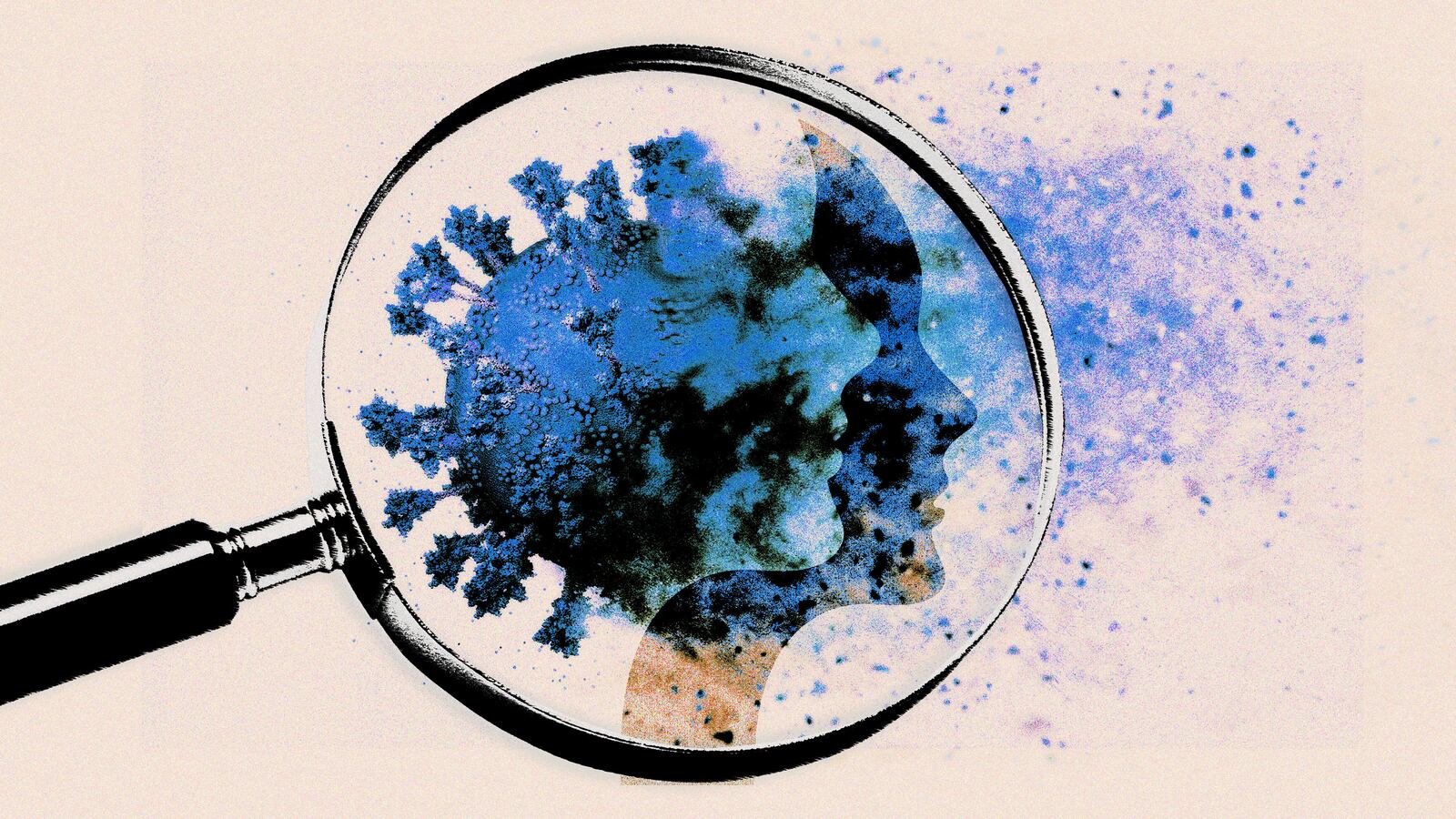In April, Marc Johnson, a molecular virologist from the University of Missouri School of Medicine, noticed something startling in the wastewater around Columbus, Ohio: High levels of a previously unknown, significantly mutated lineage of SARS-CoV-2, the virus that causes COVID-19. Not only was the lineage very different from any of the commonly circulating variants, it was a B.1.1 derivative, suggesting the person had been infected for more than two years. Adding to the mystery is the rate at which the affected individual is shedding the virus—exponentially higher than the average person infected with SARS-CoV-2.
Johnson told The Daily Beast that while the individual doesn’t pose a threat to the public, their own health “is likely affected.” He recently laid out his calculations on Twitter, writing: “I do not know of any persistent infections that shed this much virus without killing the patient… The closest would probably be [Hepatitis C], an infection that often ends in liver cancer.”
The lineage has only been detected in two Ohio sewersheds: one in Columbus, and the other in a city about 40 miles away called Washington Court House. Based on the fact that the lineage is always present in the Columbus Southerly sewershed, but not always at the Washington Court House (WCH) sewershed, Johnson assumes the individual lives in Columbus and travels to Washington Court House somewhat regularly, possibly for work.
Scientists regularly measure the levels of shed virus in wastewater as part of the metric for understanding how extensive the spread of COVID is and what kinds of variants are trending. Last month, the WCH wastewater shed had its highest SARS-CoV-2 levels ever—surpassing even the earliest pandemic peaks. Just before that May apex, researchers sequencing the WCH watershed found that all of the samples taken of SARS-CoV-2 in the watershed were from this mysterious “cryptic lineage.”
Johnson is waiting for the most recent data but he told The Daily Beast: “I bet you anything once we get that new data, the SARS-CoV-2 present is now entirely the cryptic lineage. But I’m waiting for the next round of sequencing to come out before I can really point to something publicly and say, ‘Yes, it’s increasing.’”
Cryptic lineages—or “cryptics” as Johnson calls them—are lineages of a virus, in this case, SARS-CoV-2, that are genetically distinct from the commonly circulating variants; they have mutations not found in the commonly circulating variant. Thus far, researchers have only identified a handful of cryptics. While these unusual lineages are mysterious, Johnson said there’s no indication that these lineages are contagious—if anything, the data show precisely the opposite—the lineages aren’t spreading.
That’s comforting news, but the unknowns still surrounding COVID compel scientists to continue these types of investigations. Researchers are eager to identify a person infected with a cryptic lineage of SARS-CoV-2 to learn more about how these versions of the virus can affect human health. As Johnson noted in his tweet about the case in Ohio, the level of viral shedding suggests some kind of acute infection. Finding and studying the affected individual could help researchers answer many lingering COVID mysteries, like long COVID.
Johnson is probably the best person to run this kind of detective work. He discovered his first cryptic lineage in March 2021 in St. Louis. Early in the pandemic, Johnson researched the history of coronaviruses and developed his own system for sequencing SARS-CoV-2 strains found in wastewater, which can be an excellent way to determine the scope and trajectory of viral infection in a community.
For the first year of the pandemic, Johnson was “going through reams and reams of data,” looking at all the common lineages. “It would be like ‘alpha, beta, gamma, alpha, beta, gamma, alpha,’” he said. And then, in March of 2021, Johnson discovered something unexpected: a new lineage. “I thought it must be a mistake. But then the next week, we saw the exact same thing, but only from that sewershed and nowhere else. And then it became more common, but still only in that sewershed.”
By late March 2021, the St. Louis cryptic lineage accounted for “50 percent of the sequences coming out of that sewershed. And this was not a small sewershed. It had pretty elevated SARS-CoV-2 to begin with.”
Initially, the researchers thought it was the beginning of a massive outbreak, but as the days and weeks went on, the lineage stayed exclusively in that sewershed.
“I was really freaked out by it,” Johnson told The Daily Beast, “like, I couldn’t sleep.”
And then, six weeks later, the lineage disappeared. Because they weren’t able to identify the person infected with the lineage, researchers can’t say for sure why it disappeared. It’s possible the person may have simply cleared the infection on their own. Whatever happened, researchers lost the opportunity to interview the affected individual and learn more about what the cryptic lineage’s effects may have been on that person’s health.
Since that time, researchers have found cryptic lineages in 12 other states. In most states where researchers have found cryptics, only 1-4 distinct lineages appeared in each state. In New York, however, scientists have identified more than 10.
Origin Story
While researchers haven’t been able to find someone actively infected with a cryptic lineage, history suggests that immunocompromised people are likely the most affected. “There are precedents for this, particularly the polioviruses, where people who are immunocompromised in some way become infected, but they can’t completely shed the virus. The virus then keeps multiplying in that individual,” Dr. William Schaffner, an infectious disease specialist at Vanderbilt University School of Medicine, told The Daily Beast “As that multiplication happens, the virus develops mutations, which can create sub-variants in that person… I’m ready to bet my dollar that if we could trace back to that one person, that person is likely to be immunocompromised.”
Johnson said the person might not know they’re infected with any SARS-CoV-2 variant and may not even test positive with a nasal swab if the infection is primarily in their gastrointestinal system.
“Even if someone with chronic diarrhea goes to the doctor, the doctor will probably not give them a COVID test on their stool,” he said. “And I do think they have to be having some [gastrointestinal] symptoms. I have a hard time believing there wouldn’t be tissue damage with the amount of virus they’re shedding.”
According to Johnson, someone with Crohn’s Disease could be a likely candidate, since GI distress is characteristic of that condition—though he cautioned that is just an assumption. So far, the little information available points to affected individuals who are at least “not bedridden.”
Interestingly, Johnson said that in all of the cases of a cryptic lineage he and his colleagues have followed, there always seems to be an incubation period before the person becomes a super shedder.
“We never see the intermediate versions of a cryptic lineage. They appear fully or mostly baked,” he said. “The first time we see them, they’ll have five mutations in the receptor binding domain, and then over time, they might have 12 or 13. But we never see zero, one, two, three. And we don’t know why that is.”
Figuring out the answers to those questions could have implications for treating COVID in immunocompromised people or long COVID.
“If we can answer the questions about these specific patients, we might be able to figure out the best track to help them clear the infection,” Johnson said. “And if we figure out how to clear it in these patients, we can start trying it out on long COVID patients where it looks like they might have a chronic infection.”









